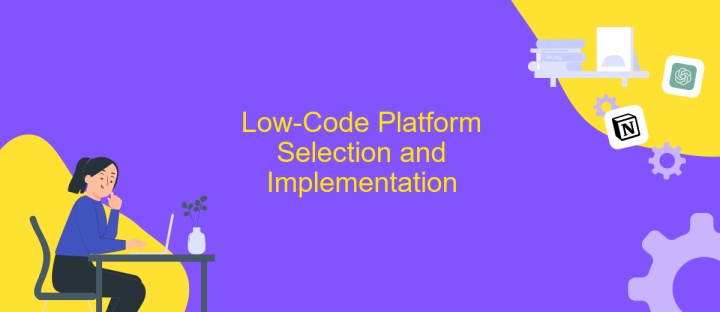Low-Code Consulting
In today's rapidly evolving digital landscape, businesses are increasingly turning to low-code platforms to accelerate their development processes and drive innovation. Low-code consulting services provide the expertise needed to harness these platforms effectively, enabling organizations to streamline workflows, reduce costs, and enhance agility. By leveraging low-code solutions, companies can empower their teams to create robust applications with minimal coding, transforming ideas into reality faster than ever before.
Understanding the Low-Code Landscape
The low-code landscape is a rapidly evolving domain that empowers businesses to develop applications with minimal hand-coding. It bridges the gap between traditional software development and the need for speed and agility in today's digital world. By leveraging visual development tools, organizations can streamline their processes, reduce development time, and enhance productivity.
- Visual Development: Enables users to design applications using drag-and-drop interfaces.
- Integration Capabilities: Facilitates seamless connectivity with existing systems and third-party services.
- Scalability: Supports the growth of applications as business needs evolve.
- Collaboration: Encourages teamwork between IT and business units for better alignment.
- Cost Efficiency: Reduces the need for extensive coding expertise, lowering development costs.
As organizations strive to innovate and adapt, understanding the low-code landscape becomes crucial. It offers a strategic advantage by enabling faster time-to-market and fostering a culture of collaboration. By adopting low-code platforms, businesses can not only meet current demands but also position themselves for future growth, ensuring they remain competitive in an ever-changing technological environment.
Identifying Business Needs and Opportunities

Understanding the specific needs and opportunities within a business is crucial for successful low-code consulting. The process begins with a comprehensive analysis of the current workflows and systems to identify inefficiencies and areas for improvement. By engaging with stakeholders across various departments, consultants can gather insights into the challenges faced and the desired outcomes. This collaborative approach ensures that the solutions developed align with the business's strategic goals and operational requirements.
Once the needs are identified, the next step involves exploring opportunities to streamline processes and enhance productivity through low-code platforms. This includes assessing the potential for integrating existing systems and automating manual tasks. Tools like ApiX-Drive can be instrumental in this phase, offering seamless integration capabilities that connect disparate applications without the need for extensive coding. By leveraging such services, businesses can quickly adapt to changing demands, reduce operational costs, and drive innovation, ultimately gaining a competitive edge in their industry.
Low-Code Platform Selection and Implementation

Choosing the right low-code platform is crucial for successful implementation. Begin by assessing your organization's specific needs, such as scalability, integration capabilities, and user-friendliness. Understanding these requirements will guide you in selecting a platform that aligns with your business objectives and technical environment.
- Identify core features required for your projects.
- Evaluate platforms based on security and compliance standards.
- Consider the platform's ability to integrate with existing systems.
- Assess the learning curve and support available for users.
- Review pricing models to ensure they fit your budget constraints.
Once a platform is selected, focus on a structured implementation process. Start with training sessions for your team to maximize the platform's potential. Develop a pilot project to test functionalities and gather feedback. This iterative approach allows for adjustments and ensures a smooth transition. Ultimately, a well-executed implementation can enhance productivity and accelerate digital transformation within your organization.
Development, Deployment, and Integration

Low-code platforms streamline the development process by allowing users to create applications through visual interfaces and pre-built modules. This approach significantly reduces the need for extensive coding knowledge, enabling faster prototyping and iteration. As a result, businesses can respond to market demands more swiftly and efficiently, ensuring that solutions are tailored to specific needs.
Deployment in low-code environments is designed to be seamless, often offering one-click deployment options. This simplicity facilitates continuous integration and delivery, allowing teams to push updates and new features with minimal disruption. Moreover, these platforms often include built-in tools for monitoring and managing applications post-deployment, ensuring reliability and performance.
- Accelerated development cycles
- Reduced dependency on specialized coding skills
- Streamlined deployment processes
- Enhanced integration capabilities with existing systems
- Improved scalability and flexibility
Integration capabilities of low-code platforms are robust, offering connectors and APIs to ensure seamless interaction with existing systems. This interoperability is crucial for businesses looking to enhance their digital ecosystems without overhauling their current infrastructure. By leveraging low-code solutions, companies can achieve a harmonious balance between innovation and operational continuity.
Ongoing Support and Optimization
Providing ongoing support and optimization is crucial to ensuring the long-term success of any low-code solution. After the initial deployment, continuous monitoring and fine-tuning are necessary to adapt to evolving business needs and technological advancements. Regular updates and maintenance keep the system running smoothly, preventing potential issues before they arise. By offering dedicated support, businesses can leverage expert insights to enhance performance, security, and user experience, ensuring that the low-code applications remain aligned with organizational goals.
An essential aspect of ongoing support involves optimizing integrations with existing systems. Utilizing services like ApiX-Drive can streamline this process by enabling seamless data flow between various platforms. ApiX-Drive simplifies the integration setup, allowing businesses to connect their low-code applications with other tools effortlessly. This not only enhances functionality but also boosts productivity by automating routine tasks. As the business landscape evolves, continuous optimization of these integrations ensures that the low-code solutions remain efficient and scalable, adapting to new challenges and opportunities.
FAQ
What is Low-Code Consulting, and why is it beneficial for businesses?
How can low-code platforms be integrated with existing systems?
What types of applications can be developed using low-code platforms?
How does low-code development ensure data security and compliance?
What are the main challenges businesses might face when adopting low-code platforms?
Strive to take your business to the next level, achieve your goals faster and more efficiently? Apix-Drive is your reliable assistant for these tasks. An online service and application connector will help you automate key business processes and get rid of the routine. You and your employees will free up time for important core tasks. Try Apix-Drive features for free to see the effectiveness of the online connector for yourself.

